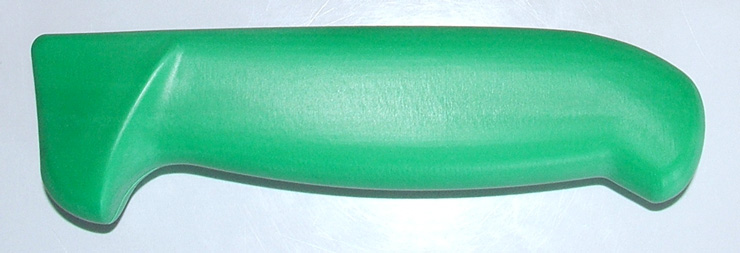
Home ›
Specials
Reverse engineering
The fine art of modeling nice-looking Zebras
A handmade model of a knife handle is already available. There's a lot of effort and know-how in it. Ergonomic and formal aspects were considered in the making. The item is situated perfectly in the hand, the proportions are optimal. Just as it is, it has to be transferred as accurately as possible into high quality surface data - tolerance 0.1 mm.
 Model of a knife grip
Model of a knife grip3D scanning
In the first step, the model with a 3D laser scanner is detected. In this optical measuring the object by means of laser triangulation with approximately 300,000 points of measurement is shown. The measurement points result in a point cloud, which in turn a fine-meshed network interface, called a mesh is generated from about 600,000 triangular planar surfaces. The entire surface of the knife handle is now closed and can be shaded using CAD software.
 Mesh: Surface topology of planar triangular surfaces. The complete volume is approximately embodied (in this case a handle half). The surface is not smooth but faceted.
Mesh: Surface topology of planar triangular surfaces. The complete volume is approximately embodied (in this case a handle half). The surface is not smooth but faceted.Analysis and planning
The next step, the mesh topology is analyzed. The surface is partially different in terms of their curvature properties (curvature) examines and interprets. This analysis, carried out with special shaders assessment helps in planning the patch layouts. The patch layout defines the structure of the individual areas.
 Curvature evaluation: False color view of the surface curvature.
Curvature evaluation: False color view of the surface curvature. Scan lines: Sorted sections in X-, Y- and Z direction.
Scan lines: Sorted sections in X-, Y- and Z direction.NURBS modelling
Similarly to a tailor, who creates patterns for a dress making, it is the reverse about a certain surface topology, taut and flowing with each plot patches to rebuild. The result is a "tailor-made surface association of individual NURBS surfaces with curvature surface transition. At the highest level of quality of execution is called class-A surfaces. For surfaces this quality of light flow into every area of the object is smooth and continuous. The areas leak risk run (fluent, addressed) through the room. The better the patch layout to fit topology, the more precise and effiziernter (minimum number of surface control points) can be mapped the surface of flowing and smooth. It is given to the best compromise between image-original and best surface quality to be found. This task can not afford to date software. Also, it is normal and not, as often assumed erroneously to a digital process in the strict sense. The process of modeling itself is completely analogous. The digital element is merely the Software and as a tool
 The reverse engineering process: Nurbs surfaces are being modelled over the mesh.
The reverse engineering process: Nurbs surfaces are being modelled over the mesh. Continous NURBS surfaces: The right patch layout enables high-quality surfaces with curvature continuous surface transitions. The zebra shader visualizes the surface quality.
Continous NURBS surfaces: The right patch layout enables high-quality surfaces with curvature continuous surface transitions. The zebra shader visualizes the surface quality. Class-A surfaces: The chrome shader shows the course of light and reflections on the object.
Class-A surfaces: The chrome shader shows the course of light and reflections on the object.Modelling vs. constructing
Why do we talk in this context of modeling and not of constructing? During the modelling process the designer as a surface modeller must make countless decisions while he forms certain areas of an object. There is no absolute criteria as in construction tasks. Each formal element is relative and is considered in relation to the topological context. The modeller interpolates the underlying mesh with NURBS surfaces at his own discretion within a pre-defined torerance and also in this microscopic small space he makes design decisions. In contrast, the engineer who works with prismatic (extruded) volumes (solids) and builds them fully parametric. The shape of these objects is characterized by severe structural parameters and boundary conditions. Simply speaking, we can say is that in the construction of a part worked predominantly orthogonal basis of a reference plane. In contrast to free-form surfaces in every imaginable direction in space and created directly on surface control points (CVs), manipulated. When designing the other hand, objects are generated by entering numerical values and can be subsequently through adaptation of parameters set up automatically. When modeling, this is not possible as a nurbs surface composite is not on absolute numerical values based parametrics based. What is more, the mathematics of NURBS surfaces is non-rational - design systems to work with, however, normally rational geometry. Free-form surfaces can, as the name suggests, can be manipulated freely and directly. This unrestrictedness degrees of freedom when manipulating surfaces gives the designer all possible freedom, but also requires a high degree of skill in using the tool, particularly in the process of modeling itself.